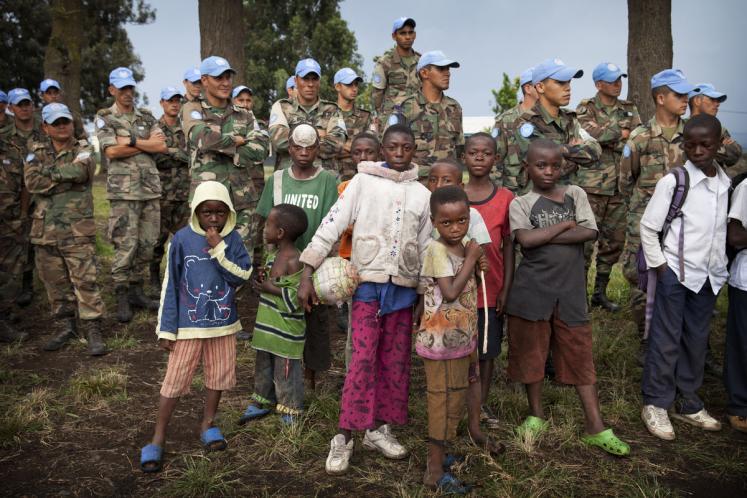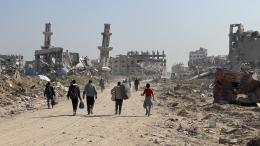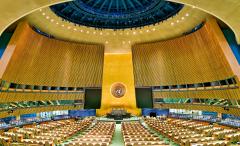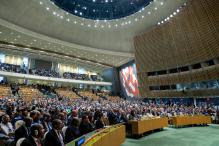On 16 June 2015, the UN Secretary-General’s High-level Independent Panel on Peace Operations (or “HIPPO”) submitted its comprehensive review of UN field missions – the first since the Brahimi Report in 2000. For those who wonder why any of this matters, consider that if the UN were a country, it would be the world’s second largest troop deployer, after the United States.
Drawing on the Brahimi Report and other previous reports like that of the 2004 High-level Panel on Threats, Challenges and Change, as well as the more recent Civilian Capacity Report, the New Horizons Initiative, and the Prodi report, the HIPPO review presents a comprehensive vision for a UN that “plays to its strengths – politics, partnership and people – to meet the challenges ahead.” Reflecting the high quality of both the panel and its research staff, all of its recommendations would, if implemented, improve the way peace operations perform.
Yet the implementation rate of recommendations in UN reform reports is, in general, no more than 20 percent – at best. A number of the panel’s recommendations have been tabled before. And the hurdles that explain why they have not been implemented – Member State politics and financial constraints – have, if anything, grown in recent years.
Somewhat unhelpfully, the report misses a compelling narrative that would persuade Member States to re-commit to peace operations with a passion, and is also too long making it unlikely to be widely read.
While it is unlikely to be the blueprint for a profound transformation of UN peace operations, it could still lead to meaningful changes that would significantly improve their effectiveness. Indeed, a team led by former Deputy Secretary-General Louise Fréchette is about to develop an implementation agenda. Meanwhile, Member States are sifting through the report to pick their most favoured recommendations. Against this backdrop we offer some thoughts below on how the report can have an impact. But first:
The shots that are too long to take
Alas, we are not optimistic with respect to some of the biggest ideas, as these are where the political and monetary constraints are the most pronounced:
-
It would be nice if the Security Council moved from reaction to prevention, but recurrent pleas to this effect since the mid-1990s have been consistently counteracted by P5 interests and sovereignty concerns of countries that fear Council engagement as unwelcome intervention. This will not change. (A far more realistic proposal, however, and one that would make a difference, is to ensure proper regular budget resourcing of the UN’s mediation, preventive diplomacy and Good Offices capacities, which, as the panel notes, are woefully underfunded.)
-
Having military forces of P5 members join peacekeeping operations would make them more robust, but significant military engagements are not viable in any of these capitals, as the former head of the Department of Peacekeeping Operations (DPKO), Jean-Marie Guéhenno, discovered when they defied his intense lobbying efforts a decade ago.
-
The deployment of a standing “vanguard force” – an idea that goes back to Article 43 of the Charter – would provide much needed rapid reaction capacity, but Member State concerns over costs and control have long stood in the way. However, as Richard Gowan has pointed out to the authors, it might be possible to create rapid reaction reserves in West and Central Africa as part of draw-down plans for missions in Cote d’Ivoire, Liberia, the DRC and Darfur.
-
Yes, the use of UN assessed contributions for Council-mandated regional operations, first recommended in 2004 and then again in 2008, would certainly give meaning to the much-heralded AU-UN partnership. But the P5 – along with the other big financial contributors to the UN like Japan and Germany – will continue to adamantly oppose this. They fear that doing so even once will increase the pressure to do so every time.
This does not mean that the panel should not have tabled these proposals. But we hope that Member States will not make progress in other areas hostage to the implementation of any of these relatively unrealistic recommendations.
The conceptual fudges
Meanwhile, on the major conceptual questions on which the panel was expected to pronounce itself – When should peacekeepers use force? Are the peacekeeping principles, like use of force only in self-defence, impartiality, and consent of the host country, still valid? How can we ensure more consistent protection of civilians (PoC)? Should UN peacekeepers engage in counterterrorism operations? – the panel responded with a bit of a fudge. But given how divided Member States are on these questions, nobody will be terribly happy or unhappy.
-
On the use of force, the panel concludes that in light of the UN’s well-known capability limits, mandates such as that for the Force Intervention Brigade in the Congo were at best temporary band-aids and should be applied “with extreme caution.” But for a robust stance to be viable, the Brahimi Report’s dictum from 15 years ago remains as relevant as ever: when it comes to required resources, the SG needs to tell Council what it needs to know, not what it wants to hear.
-
On the validity of peacekeeping principles (use of force only in self-defense, impartiality, and consent), the panel was ultimately unable to resolve the growing tension between the old doctrine and new requirements brought about by messy conflict environments and the growth of protection of civilians mandates. Realizing that revision of the principles would trigger a backlash among much of the Non-Aligned Movement (NAM), the panel ruled that the principles should remain valid – except when they shouldn’t – and called for flexible application. The fact that the UN had previously reinterpreted “self-defense” into “defense of the mission” already provides a high degree of leeway, meaning not much will change in practice.
-
The panel was similarly pragmatic on the protection of civilians, pointing out the limits that 106,000 peacekeepers face in ensuring the protection of all civilians across the total of 11 million km2 that the UN’s 16 operations are covering today. Yet, the reluctance of UN troops to use force when civilians are threatened has been a deep embarrassment to the UN. The HIPPO recommends, inter alia, that force commanders treat any “national caveats beyond the national restrictions expressly accepted by the Secretariat at the outset” as disobedience of lawful command. In return, ensuring that key troop contributors are properly consulted in the process of formulating Council mandates should also go a long way in strengthening their buy-in for robust protection. Particularly in this area, we think the panel could have been more forceful in highlighting contributions to protection by the UN’s civilian components and calling for their strengthening.
-
On counter-terrorism operations, the panel, to the chagrin of France, was crystal-clear in arguing that this falls outside of what UN forces can be expected to perform. That said, the panel failed to address challenges arising from significant counter-terrorism functions assumed by civilian personnel in a number of UN Missions, for example through counter-terrorism efforts dressed up as disarmament, disengagement, and reintegration (DDR).
While the P3 (the United States, United Kingdom, and France) and many AU members will surely have hoped for a more robust posture by the HIPPO, it has produced a report that reflects the politics of the UN of today. Perhaps drawing on the words of Jean-Marie Guéhenno, peacekeepers are not “a SWAT team that’s going to clean up a bad neighborhood” – this might have been the best that could be achieved.
The winners: un-sexy but relevant and achievable
So what are the recommendations in the report that promise reasonable returns on investment? In our view, they are buried deep in the report:
-
The panel proposes a compelling set of recommendations that would improve the UN’s perennially deficient planning of peace operations. They largely draw on the UN’s positive experience in planning the Libya mission in 2011, where a senior official was tasked well in advance of a Council mandate, which everyone knew would eventually materialize, to lead an integrated, system-wide planning process and develop a set of deployment options for different scenarios. Libya is a mess, of course, but this is not a function of the early planning of the mission, which was far better than the norm.
-
In a closely related recommendation, also pioneered in the Libyan context, the panel recommends that the Security Council adopt the practice of “a two-stage mandating process requiring the Secretary-General to return to the Security Council with proposals for prioritized mission tasks within an initial six month period.” This is easy to implement and makes eminent sense, as it would allow the Council to adjust the mandate to changing conditions on the ground and take into account the priorities identified by the UN’s early field presence.
-
The panel also compellingly recommends the establishment of a small strategic analysis and planning capacity in the SG’s office to address the UN’s strategic analysis deficits in the context of mission planning, which currently tends to take the form of short-term “strategic assessment missions” by UN staff with often little country expertise. Realizing the UN’s lack of area expertise in countries that do not already host a peace operation, the panel emphasizes the need to involve outside expertise into the process. And in light of the growing impact of organized crime on post-conflict peacebuilding, the panel rightly highlights the importance of “analysis of economic dimensions, resource flows and revenue or illicit power networks.”
-
The panel also points out that the missions themselves, once established, need to be given the capacity to more easily access expert analysis and research to support mandate implementation. This is not without issues – departments are loath to surrender planning authority, and previous efforts at this same goal have all failed. But it remains overdue.
-
The HIPPO identifies as critical the recruitment of high-quality Special Representatives of the Secretary-General (SRSGs), an area where there remains room for improvement. Here, the panel calls for an ad-hoc group of former senior field leaders who would informally interview and vet candidates as part of the recruitment process. While this mechanism is not a sure-fire way to ensure quality control across the board, it would likely prevent the most harmful mis-hires, which can sink entire missions.
-
The HIPPO also makes compelling recommendations on wider UN recruitment procedures, which, as they rightly point out, “are failing missions and their mandates.” This is particularly true in terms of the difficulty mission leadership faces in hiring key staff, firing dead wood, and ensuring mobility and career development for staff. The panel pragmatically suggests the introduction of “a framework for extraordinary measures that allows expedited and effective administrative procedures, particularly for procurement and human resources.” While this will help, we think that what is needed in the mid-term is a root and branch reform of the entire UN’s human resources system, which should be among the top priorities of the next SG.
-
Another of the HIPPO’s recommendations whose time has clearly come is to reform the systems to support the funding arrangements of the UN’s political field missions, in line with those available to UN peacekeeping operations, to ensure a speedy mission start-up and facilitate the mission’s retooling (or expansion) in light of changing circumstances on the ground. An earlier reform push on that front has run into the opposition of the P5 who balk at the creation of a single “peace operations account,” as it would move the financing of political missions to the peacekeeping scale of assessments where the P5 pay a premium of a few percentage points relative to their assessed contributions to the UN’s regular budget. However, the actual additional expenses for the P5 would be comparatively low. For 2014, the US, for instance, would have paid an extra $40 million, while the UK would have paid an extra $9.5 million. If the SG’s implementation team can present a compelling case of how reforming funding arrangements would improve the performance of political missions on the ground, it is well possible that the P5 will come around on this point.
-
Among the panel’s strongest, yet eminently implementable recommendations, are those around addressing abuse by UN peacekeepers and enhancing accountability. Criticism of the UN’s response to alleged child abuse by French troops in the Central African Republic, as well as earlier cases of abuses by UN peacekeepers illustrate how failing to address this issue properly can damage the UN’s credibility. The HIPPO’s suggestions to have the SG report on failures by troop contributors to investigate and prosecute cases of abuse and sanction those Member States who fail to comply will not be popular among some troop-contributing countries (and their militaries), but these are essential steps to maintain the legitimacy of the peacekeeping endeavor.
-
Finally, the panel proposed establishing a second Deputy Secretary-General for peace and security. This is a revival of a recommendation originally tabled in 2004 to improve the dysfunctional strategic coordination of key UN departments in crisis situations. Based on the model of the US national security advisor, the 2004 proposal was shot down at the time by the heads of the peacekeeping, political and humanitarian affairs departments who feared the insertion of a new layer between themselves and the Secretary-General, which led to the creation of the SG’s Policy Committee as a compromise solution. While the Policy Committee has become a useful decision-making tool on longer-term policy issues, it has failed to ensure crisis coordination, therefore, the model of a second DSG remains compelling to us.
The way forward
Like all of its worthy predecessors, the HIPPO’s recommendations will live and die on the political strategy around its implementation. Unfortunately, there is no evidence that the High Level Panel managed to establish a political consensus around key ideas of the report.
What then can the Secretary-General do with the report to improve peace operations and in doing so, burnish his legacy? We believe that the report contains the right elements for success, if the SG and his team can take three basic steps:
(1) Low-hanging fruit
The first job of the SG’s implementation team should be to identify what steps the Secretary-General can take within his authority.
This is not easy. There has been considerable pressure in recent years from a few critical Member States to shrink the scope of actions available to the Secretary-General. The Report will need to clearly lay out both the basis for actions being taken within the Secretary-General’s authority, as well as the mechanisms by which these decisions will be brought to the Member States. This, above all, will be the task of the implementation report.
(2) Political planning
US President Barack Obama plans to convene a peacekeeping summit in September, with his fellow world leaders. Many of the recommendations in the report will require explicit Member State backing at a senior political level. The SG’s implementation team will have to quietly work with the US mission and other key capitals to identify 2 or 3 important decisions that could be endorsed by a high-level grouping. This would be a rare opportunity, for example, to unite world leaders around the few most significant reforms recommended in the HIPPO report. Making progress on strategic force generation will surely be key, not least as will having some potential excess supply of capable troops be a prerequisite for raising the bar on the quality, performance, and accountability of peacekeepers.
(3) Structural issues around the United Nations
Some of the implications of the report are structural. Taken in conjunction with the forthcoming report of the Advisory Group on Experts for the Review of the Peacebuilding Architecture, the post-2015 development agenda, and the 2016 World Humanitarian Summit, the case for significant structural reform of the UN is building.
We believe major institutional reforms should await the arrival of a new Secretary-General for the following three reasons:
-
The full implications of the other three key elements in play (peacebuilding, humanitarian, development) are not known. The Sustainable Development Goals will be agreed in September, but the implications of that agreement will take a year or more to work through. The World Humanitarian Summit is scheduled for June 2016. Reform now would be based on an inadequate understanding of needs.
-
The level of necessary political consensus is simply not present. None of the reform processes have overcome the climate of political tension in New York. In the absence of political consensus, reform will be piecemeal.
-
Ban Ki-moon’s term as Secretary-General will conclude in December 2016. If he waits, at a minimum, for these processes to work themselves out, he will be scrambling to implement structural reforms in the few months between the World Humanitarian Summit and his departure – perhaps while his successor waits in the wings. Serious structural reform in the last days of the SGs tenure will not be legitimate, and will leave an unfortunate legacy.
One of the HIPPO recommendations (144/6) is for an “independent review of the current capacities of United Nations agencies, funds and programmes to aid in sustaining peace and their potential enhancement.” We would urge the implementation team to launch this review early next year, and time its conclusions for, say, the 100th day of the tenure of the new Secretary-General. Doing so would allow Ban to ensure that this reform process has legs, but also give him a graceful way to pass the baton on to his successor.
Suggested citation: Sebastian von Einsiedel, Rahul Chandran., "The High-Level Panel and the Prospects for Reform of UN Peace Operations," UNU-CPR (blog), 2015-07-14, https://unu.edu/cpr/blog-post/high-level-panel-and-prospects-reform-un-peace-operations.




